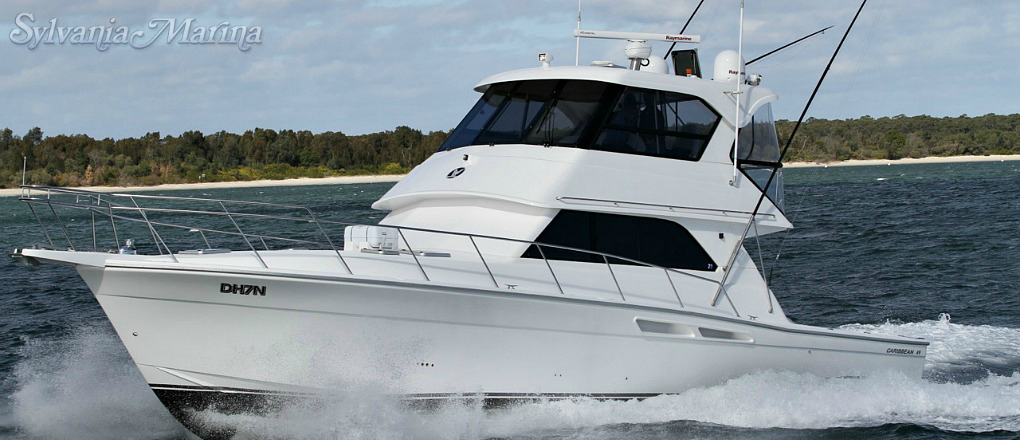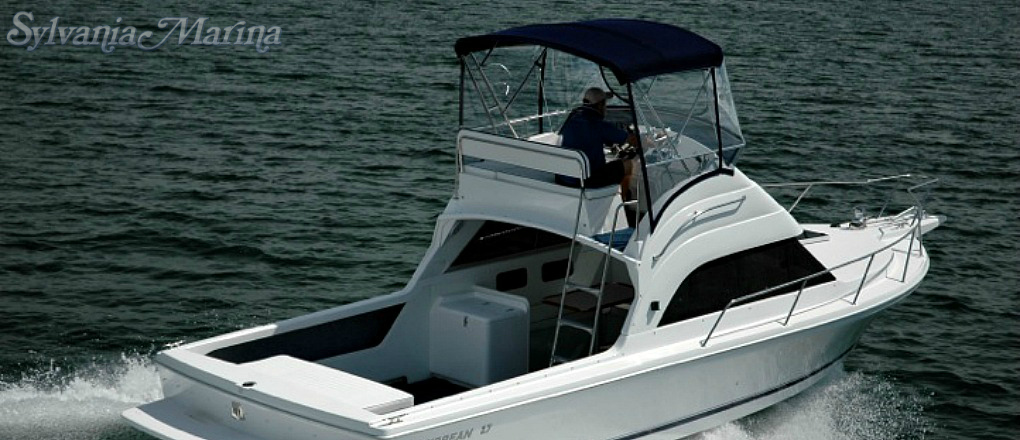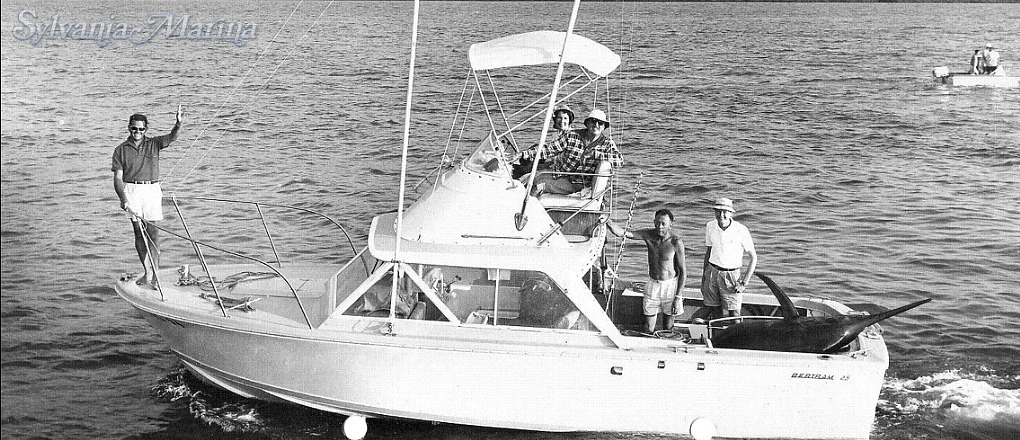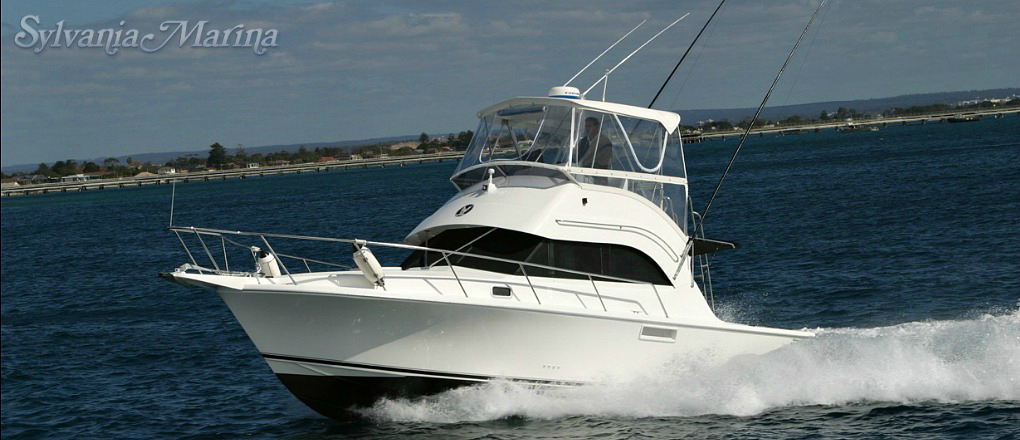2004 Caribbean 47 Boat Review

When you’re ready to partake in some coastal cruising, kitted out for holidaying afloat and itching to live aboard with friends or family, there are certain things you must have.
You will covet comfort from the beds to the heads; need personal space, storage space and privacy; seek restful seats from the helm to the saloon; want high headroom, lots of fridge space… these kinds of things.
You’ll also want big fuel tanks for a long cruising range, the latest electronic motors for efficiency and smoke-free operation, and an easily driven hull that glides across the waves. You will need water capacity, power generation for things like air-con units, and a big holding tank capacity to better fit in today’s environmentally conscious world.
Like the sister ships that have gone before it, the new Caribbean 47 is geared for offshore cruising, bluewater fishing and liveaboard boating. You don’t need to step aboard to realise this – 2700lt of fuel, 650lt of water and a 128lt holding tank will serve the purpose well.
The Caribbean compares favourably with the Riviera 47, with its 2300lt fuel capacity, 620lt water and similar-sized holding tank. Both boats have triple cabins and twin heads, which takes care of the privacy issue and makes for a very accommodating home away from home.
Going on hull length, which excludes bowsprit and boarding platform, the Riviera 47 is 0.96m longer than Caribbean’s 47 – but the latter is wider by 3cm. In fact, for its length, the new Caribbean is a very beamy and stable boat. And it’s no lightweight.
Fitted with standard twin 700hp C12 Caterpillar engines – this is the first Caribbean ever with electronic motors – the 47 has a good turn of speed. The Riviera with twin 535hp motors weighs 4500kg less. So the Caribbean 47 can be viewed as a heavy boat for its length – a quality many associate with seaworthiness.
But the big thing that differentiates the Caribbean from the Riviera is a fully enclosed flybridge. In the manner of all good convertibles, the boat has a single station as standard. Boaters in southern climes can order a lower helm station if they feel they must, but really the 47 flybridge is cruising and people friendly.
Put it all together and you have a boat that I’d be happy to live aboard with another couple at least. And, it seems, so would a lot of other cruising types. Two Caribbean 47s are in Sydney already, a couple more are on the way, and the Melbourne-based boatbuilder International Marine had hull No 7 in the factory at the time of writing.
The forward sales of the new 47 are just rewards for a boat that was four years in the making. Over the past few years, these boats have become a lot smarter, with rounded mouldings, classy soft furnishings and stylish high-gloss teak joinery too.
DESIGN LINES
Caribbean’s 47 has the same contemporary design as the company’s highly successful 40. A lot of 40 owners were jumping aboard the 47 at this year’s Sydney boat show, and I would expect plenty of them to upgrade based on the fact that the boat has two heads and three cabins, making it great for weekending away with guests.
The hull is fashioned from solid handlaid GRP in the manner that Caribbeans have been made for decades. There is no keel, a couple of strakes per side, some rake to the bow and a gently sloping sheerline for looks. The engine bearers are ‘glass-encapsulated timber and the hull is supported by a grid system of stringers.
The hull shape is high volume, designed to accommodate the island berth in the bow. The 47, says dealer Nathan Ghosn, could be considered a cross between the bluewater favourite we know as the 35 and the more beamy 40. The bridge, while heavy looking, works when you are aboard. There’s lots of headroom, seating and great views ahead and astern.
Viewed from astern, the Caribbean 47 certainly has a broad cockpit. The outdoor playpen measures 13.30sqm, which is big enough to swing a gamechair and entertain a throng in summer – especially if you fit an awning over the cockpit. Add a table and chairs and, shazam – lunch setting.
The boat’s decks, meanwhile, are traced by a typically practical and high rather than pretty bowrail. Rather than bow to fashion, the unsexy upright rail traces the deck at thigh height. Add cabin-side grabrails, moulded toerails and non-skid decking, and you have safe access to the bow. The boat can be fitted with a 350kg tri-fold davit for lifting a tinnie up to, say, 3.6m.
ALL ZHUSHED UP
To this foundation, Australia’s biggest Caribbean dealership, Sylvania Marine – which has the distributorship for the Caribbean 47 throughout NSW and has plans for a dealership in Queensland – did a ‘straight-guy’ makeover to make the 47 more of a metro boat for family and fishing.
“The days of selling a 95 per cent fish boat, where crews come aboard and, say, put the berley pot here, a downrigger there, are no more,” explains Ghosn. “These days the boats are designed for 50/50 fishing and family use.”
Indeed, everyone can enjoy boating aboard the 47. With three cabins, two double beds and two bathrooms, this can hardly be considered a selfish boat. Compared to the Caribbean 42 and 45, which were huge in their day, the new 47 offers an extra cabin and a flybridge hardtop – not to mention far better finishes.
Options on the demo boat included an air-conditioning upgrade to the bridge and third cabin – the standard two units do the saloon and front cabin only – Reelax Mini outrigger bases with 6.1m poles, a Furuno Navnet electronics kit including two 10in colour screens, marine radios, a factory bedding package, and more.
The test boat came with a 13kVa generator, double shorepower leads and 15amp plugs so you can run a full house of appliances and conveniences without tripping switches. Engine room access is under the saloon floor.
I noted good access around all sides of the Caterpillar motors, which were linked to traditional wet-box mufflers; PSS dripless shaft seals; and Twin Disc electronic Quickshift gearboxes. These gearboxes are great to use, with three different set idle speeds and a synchro function.
The boat has bronze seacocks with ball valves on all the through-hull fittings below the waterline, including the eutectic saltwater pickup, air-con cooling-engine pickup and generator pickup. The hot-water tank is 75lt, while there’s an automatic battery charger, Racor fuel filters and room aft elsewhere in the engine room for carrying oil, tools and so on.
The boat’s watertank is a 900lt integral GRP number, so add an inline charcoal filter if your want sweet drinking water. The aft fuel tanks carry 1350lt each per side and have fuel shutoff taps under the cockpit hatch, where the fuel filler is located.
All the in-floor cockpit hatches have overboard drains around them, and the self-draining cockpit has rubber scuppers. There are three separate watertight compartments underfloor, each with automatic bilge pumps and high-water alarms.
But the best feature for serious liveaboard boating has to be the lazarette. The step up into the saloon lifts to reveal a lazarette storage area big enough to sleep a family of stowaways. More likely it will be used to keep inflatables, outboards, dive gear, fishing gear, bait or berley, clean equipment and so on.
OUTDOOR LIVING
The 47’s broad transom is traced by a boarding platform with enough room for a couple of bronzed bodies to lie on beach towels – in calm water at least. There is also a concealed swim ladder and a transom door that opens outwards, as it should.
There are small hawsepipes in the corners of the deck and internal cleats. Such a setup is preferred by hardcore fishers, since it reduces the chance of fouling line; but it is not the kindest way to deal with mooring lines for ladies or unfamiliar crew.
I consider the 47’s cockpit a class-leader in terms of being able to get your toes under the gunwales so as to obtain thigh support. The deck was covered in a subtle but effective non-skid pattern, and there was plenty of storage in big sidepockets. I found both a freshwater H/C handheld shower and a saltwater washdown.
Gamefishers will welcome the twin in-transom livebait tanks, which each carried about 150lt. Sylvania Marine usually adds a viewing window and fits the tanks with Jabsco continuous-flow through-hull pumps. One of these tanks can be used for carrying dead baits or the catch when loaded with ice.
The starboard-side amenities centre under the flybridge overhang can be used as a rigging centre when fishing. Closed, the moulded lid doubles as an undercover seat. Open, you will find storage in timber drawers and a sink with a second handheld H/C shower. Alongside is a eutectic fridge/freezer with a capacity of about 200lt.
Floodlights and stereo speakers are recessed under the flybridge brow. An upright ladder with metal steps – which are solid but not particularly pretty – leads to the lofty flybridge. There is a lockable safety/security cover over the ladder too.
LIVEABOARD BRIDGE
You can cruise in comfort from the big balcony in the sky. The flybridge offers protection from the elements behind glass panes, has four air-con outlets (though none are directed onto the windscreen), and sliding windows for cross-flow ventilation.
The white mouldings and upholstery are very white and bright. There are stainless support bars or handrails here and there.
Seating comes by way of a portside lounge for three people, while an L-shaped lounge around a moulded table ahead of the helm can seat four to six. Add the skipper and navigator seat and you have room for 10 people, should relevant waterways authorities allow such a load.
The bridge amenities centre includes a stainless-steel sink with H/C water and a fridge for refreshments. Sylvania Marine was fitting a power outlet in the bridge so you could run a kettle, recharger or whatever. One hopes there is an option to convert the L-shaped lounge and dinette into a daybed or skipper’s quarters for those nights at less-than-ideal anchorages.
The entire console hinges forward for direct access to the wiring, which is coded. The boat has an overhead moulded radio box, hardtop hatch for folding aerials or cleaning seagull droppings. There’s an AM/FM CD player with speakers to the bridge and cockpit, as well as a 12V socket for charging the mobile phone.
The console has been designed to take two 10in navigational display screens. Aside from the easy-to-operate Furuno Navnet and Navpilot, equipment there was a spotlight control, tank gauges, rudder gauge, chain counter, trim-tab switches, wipers with washers, circuit breakers and audio/visual bilge alarms. From my experience, Pompanette helm chairs are excellent seats.
LIVING AREAS
Indoors, the 47 is no less welcoming. The saloon and galley are just a step apart, meaning the cook can stir pots and crew.
The pleated bone-coloured curtains and leather upholstery on the lounges looks the part with the cream liners and high-gloss teak joinery. Clean and simple. You can add colour with curios, scatter cushions and creative personal touches.
The U-shaped lounge around the teak dinette to port can seat six people. Opposite is a lounge/daybed that can be converted into a 3/4 double bed and a Pullman berth. This boosts the boat’s sleeping capacity to around nine. That could be a selling point.
Good headroom ranges to the entertainment centre to starboard, with a 50cm flatscreen TV, DVD, AM/FM radio and CD stacker. The wet bar in the teak cabinet includes an icemaker, bar fridge and storage. There are opening side windows and air-con to help diffuse cooking odours.
Like most Caribbeans, the galley has generous counter space. The U-shaped area, which is preferred at sea, has a big teak servery with fiddle rail, deep stainless-steel sink, lots of drawers, shelves and lockers, and a concealed top-loading garbage bin – which will be keenly patronised when living and cooking aboard.
I admired the bar-style, counter-height, side-by-side eutectic fridge (240V only) and separate freezer with stainless-steel facias. The only fridges running off 12V are the two bar fridges.
I also noted a must-have convection microwave/grill, dishwasher (which, alas, will use lots of water when away from the marina) and a two-burner electric Miele hotplate traced with – good stuff – a pot holder. Flooring is teak and holly.
BED AND BATH
The Caribbean 47 will work as well for a family with children as it will for two discerning couples. Stepping down from the living area, there is a cabin immediately to port with a double bed about 1.85m long. Storage comes by way of overhead lockers and drawers, but there’s no hanging locker.
The kids’ cabin opposite has two bunks, but they are actually adult-width and very comfortable. The cabin’s lower bunk has a small return that you could use as a seat. But still no hanging locker.
In the bow is a masterly master cabin with and island double bed finished in a tasteful tomato-and-gold-patterned spread. Various combinations of this were used throughout the cabins. The master cabin had, hooray, his and hers hanging lockers, and headroom and floor space to dress.
Owners have their own en suite with the popular Vacuflush loos, separate shower stall, TankWatch gauge, moulded sink and big storage lockers for personals. The dayhead has a door back into the companionway but no en suite function for the second guest’s cabin. There is a full shower stall and Vacuflush loo here too.
To empty the holding tank you need to crawl into the engine room, flick a tap to activate the pump, check the TankWatch gauge, turn the pump off when the tank is empty, then return to the engine room to close the valve. I mention this because on some other boats, all you do is flick a switch on the control panel. Caribbean should consider this.
I couldn’t find extractor fans in the heads, but they are certainly spacious. They had bevelled mirrors, but ladies might appreciate a full-length mirror somewhere on the boat. Otherwise, the 47 was a cut above past Caribbeans in terms of finish.
CRUISING EAST
You’ve gotta love the advances that electronics are having on marine diesels. Once rattly and smoky, the C12 Caterpillar engines on the 47 are now smooth, quiet and smoke free. MTU will tell you that Cats are among its most praiseworthy rivals.
Spinning four-bladed propellers, the twin 12lt C12 engines propelled the half-laden boat to 24kt at 1920rpm using 130lt/h in total. Comfort cruising was at about 20kt, where the motors consumed 100lt/h. Flat chat, the boat did 31kt.
But what I would consider economical cruise speed if I were paying the fuel bills was about 18.5 to 19kt for a collective consumption of 84lt/h. This will give the 47 a theoretical range of more than 500nm, leaving 10 per cent of fuel in reserve.
So you could go from Botany Bay to Southport – a journey of about 450nm – non-stop in the Caribbean 47. Fly home, fly back up for a few weeks on the Gold Coast, flash by Tangalooma then park the boat at Mooloolaba. Next thing you know you’re at Lady Elliot, Port Curtis, and into the islands. The only thing you need is time.
HIGHS
- Good living space from the bridge to the saloon and galley
- Big heads with home-away-from-home showers and odour-free Vacuflush heads
- Huge cockpit for fishing and lazarette storage for cruising
- Electronic Caterpillar motors are smooth and economical
- I like the Quick Shift boxes from Twin Disc
- Cruising range to go places
LOWS
- Heavy-looking hardtop
- Holding tank a hassle to dump
- No extractor fans
- No full-length mirror
- Main guest cabin should have a hanging locker
- Only bar fridges run off 12V
- No 240V outlet in bridge
|
**Review written 2004







Connect With Us